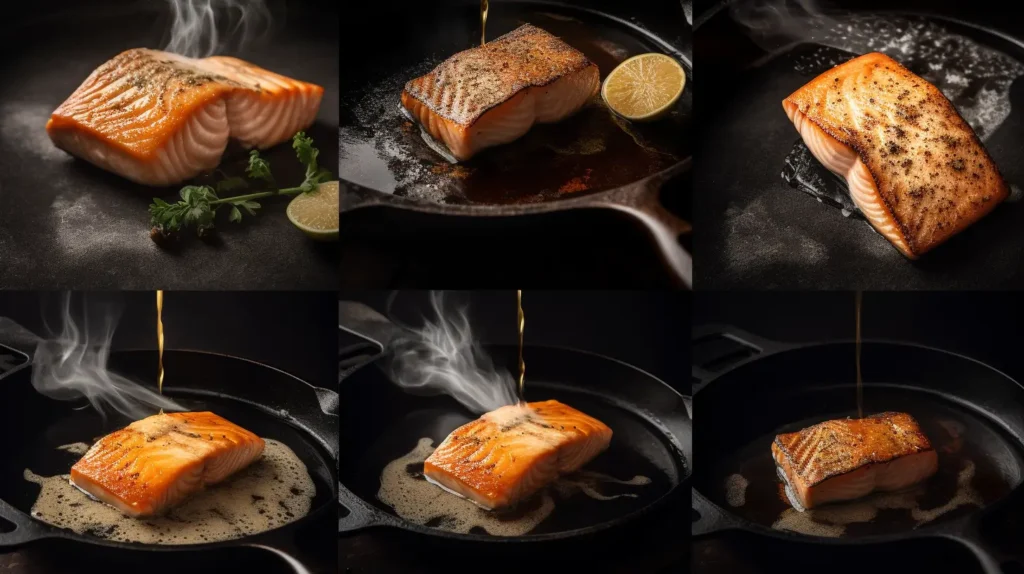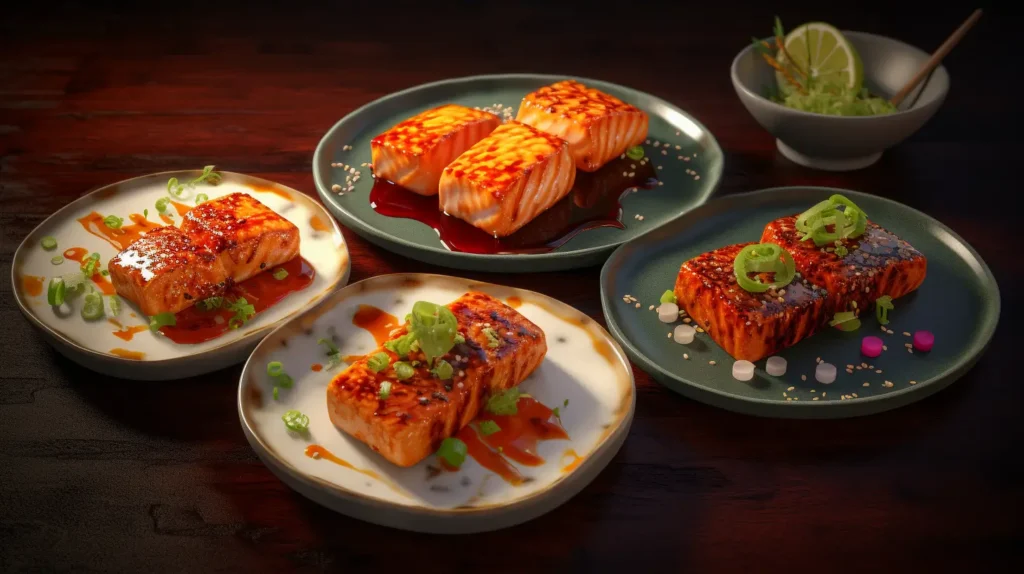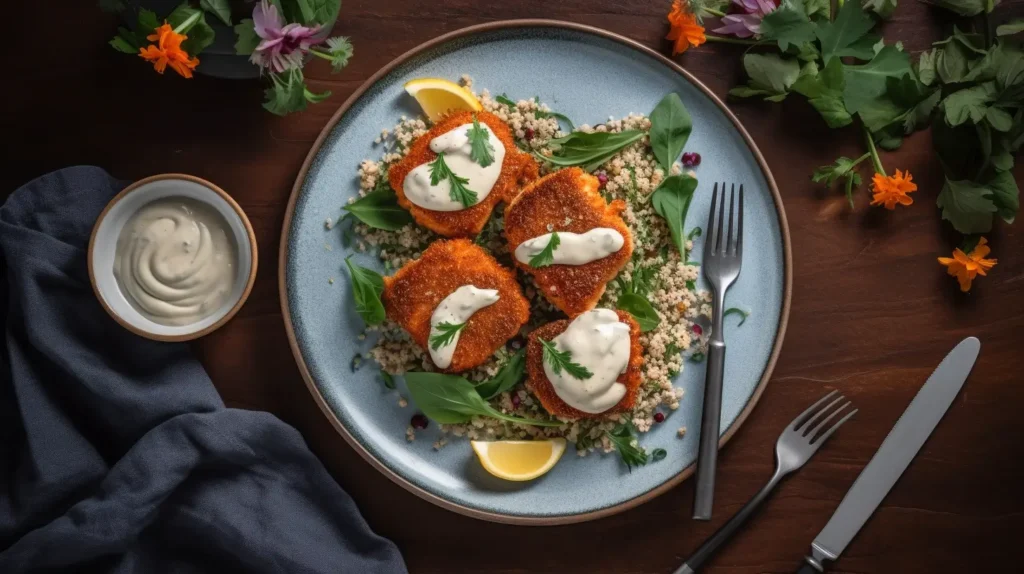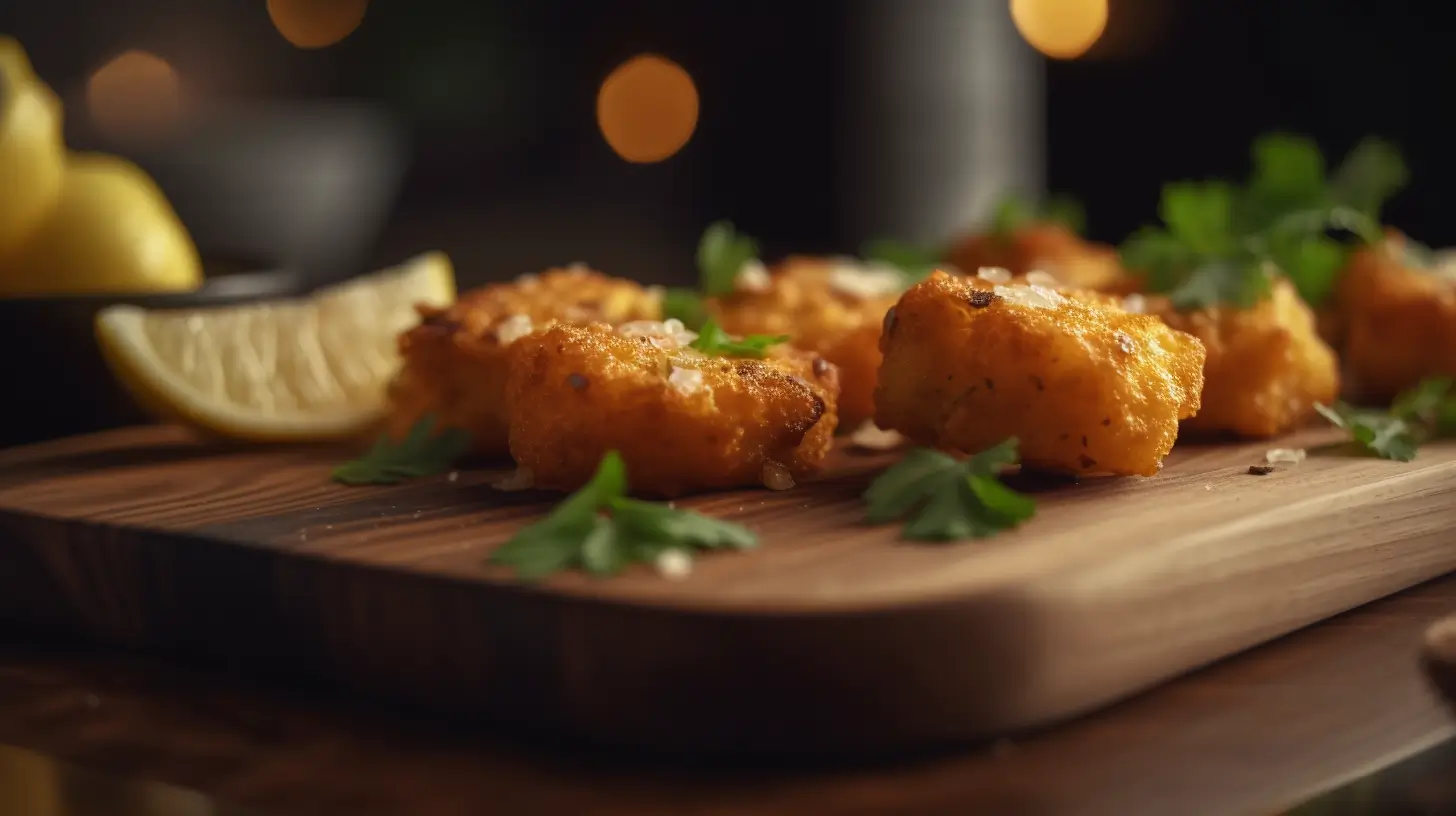Salmon bites are a game-changer when it comes to quick, delicious, and healthy meals. Whether you’re looking for a light snack, a party appetizer, or a full meal, these bite-sized salmon pieces pack a punch of flavor while being loaded with omega-3s, protein, and essential nutrients.
In this guide, we’ll walk you through everything you need to know about making the perfect salmon bites recipe—from choosing the best ingredients to different cooking techniques and must-try variations. Whether you prefer them pan-seared, baked, grilled, or air-fried, we’ve got you covered.
So, grab your favorite seasonings, and let’s dive into the best ways to make crispy, flavorful salmon bites!
Table of Contents
1: Introduction to Salmon Bites
What Are Salmon Bites?
Salmon bites are small, bite-sized pieces of salmon that are typically marinated, seasoned, and cooked until crispy on the outside and tender inside. These little morsels are packed with flavor and nutrients, making them a popular choice for quick dinners, meal prep, or appetizers.
Unlike full salmon fillets, these bite-sized pieces cook faster and offer more surface area for marinades and seasonings to soak in. That means more flavor in every bite!
Why Are They So Popular?
The versatility of salmon bites is what makes them a hit in the kitchen. You can serve them as a high-protein snack, toss them in a salad, pair them with rice or quinoa, or enjoy them with your favorite dipping sauce. Plus, they can be cooked in multiple ways—baked, air-fried, grilled, or pan-seared—for different textures and flavors.
Some of the top reasons people love salmon bites include:
Quick cooking time—ready in under 15 minutes!
Packed with healthy omega-3s and protein
Endless flavor combinations with different seasonings
Perfect for meal prep and reheating
Crispy, juicy, and downright delicious
Different Cooking Methods for Salmon Bites
One of the best things about salmon bites is how easy they are to cook. Here are some of the most popular cooking methods:
- Pan-Seared: Perfect for a crispy crust and deep flavor.
- Air-Fried: A healthier alternative with a crispy finish, using little to no oil.
- Oven-Baked: Simple and fuss-free, great for meal prepping.
- Grilled: Adds a smoky, charred flavor that enhances the natural richness of salmon.
Each method brings out different textures and flavors, so you can choose one based on your preference and time constraints.
2: Ingredients for the Perfect Salmon Bites
Choosing the Best Salmon: Fresh vs. Frozen
When making the perfect salmon bites recipe, the first step is picking high-quality salmon. Should you go for fresh or frozen? Well, both have their perks!
- Fresh salmon has a richer flavor and better texture, especially when sourced from a trusted fish market. Look for vibrant orange or pink flesh that’s firm and not slimy.
- Frozen salmon is a fantastic alternative, especially if you don’t live near the coast. Just make sure to thaw it overnight in the fridge or under cold running water for the best results.
If you’re wondering which type of salmon to buy, wild-caught varieties like sockeye or coho tend to have a deeper flavor and more nutrients than farmed salmon. However, farm-raised salmon is usually fattier, making it ideal for a juicier bite.
Essential Seasonings and Marinades
A great salmon bites recipe is all about the seasonings and marinades. Whether you like bold, spicy flavors or a light, citrusy touch, here are some key ingredients to elevate your dish:
Salt & Pepper: The base for any great seasoning mix.
Garlic Powder & Onion Powder: Enhances the savory depth.
Smoked Paprika: Adds a subtle smoky heat.
Soy Sauce or Coconut Aminos: Brings umami richness.
Honey or Maple Syrup: Balances flavors with a hint of sweetness.
Lemon Zest or Juice: Brightens up the dish and cuts through richness.
Cayenne Pepper or Red Pepper Flakes: For those who love a spicy kick!
Additional Ingredients for Extra Flavor
Want to take your salmon bites to the next level? Try adding these:
- Sesame Seeds & Green Onions – Perfect for an Asian-style salmon dish.
- Dijon Mustard – Adds a tangy, slightly spicy note.
- Parmesan Cheese – Great for an oven-baked salmon bites variation.
- Butter or Ghee – Boosts richness when pan-searing.
3: How to Make Salmon Bites – Step-by-Step Guide
Preparing the Salmon: Cutting & Seasoning
The key to perfectly cooked salmon bites is cutting them into even-sized pieces. Here’s how to do it right:
- Pat the salmon dry using paper towels. Removing excess moisture helps it crisp up better.
- Remove the skin (optional) – If you prefer, you can leave it on for extra texture.
- Cut into 1 to 1.5-inch cubes – Keeping them uniform ensures they cook evenly.
- Season generously – Toss the salmon cubes in a mix of salt, pepper, garlic powder, and your favorite spices.
Marinating for Maximum Flavor
If you have time, marinate the salmon for at least 15–30 minutes before cooking. This step isn’t mandatory, but it allows the flavors to really soak in.
Simple marinade recipe:
- 2 tbsp soy sauce
- 1 tbsp honey
- 1 tsp minced garlic
- 1 tsp sesame oil
- ½ tsp ground ginger
Whisk everything together and coat the salmon well. Let it sit in the fridge, and you’ll be rewarded with extra-tasty bites!
Cooking Methods: Air Fryer, Pan-Seared, Baked, or Grilled
Now comes the fun part—cooking your salmon bites! Each method offers different textures and flavors, so pick one based on your preference.
Air Fryer Salmon Bites (Best for a crispy texture)
- Preheat the air fryer to 400°F (200°C).
- Lightly spray the basket with oil to prevent sticking.
- Place the salmon bites in a single layer, ensuring they don’t overlap.
- Cook for 8-10 minutes, shaking the basket halfway through.
Pan-Seared Salmon Bites (Rich and flavorful)
- Heat a non-stick pan over medium-high heat. Add 1 tbsp of oil.
- Once hot, add the salmon bites in a single layer. Don’t overcrowd the pan!
- Cook for 2-3 minutes per side until golden brown and crispy.
Oven-Baked Salmon Bites (Easy and healthy)
- Preheat the oven to 400°F (200°C).
- Line a baking sheet with parchment paper and spread out the salmon cubes.
- Bake for 12-15 minutes, flipping halfway for even cooking.
Grilled Salmon Bites (Smoky and delicious)
- Preheat the grill to medium-high heat.
- Thread salmon cubes onto skewers for easy flipping.
- Grill for 2-3 minutes per side, until lightly charred.
No matter which method you choose, the result will be tender, juicy, and packed with flavor!
4: Best Cooking Methods for Salmon Bites

Not all cooking methods are created equal when it comes to making the crispiest, most flavorful salmon bites recipe. Whether you love a golden, pan-seared crust or a light and flaky baked version, each method offers something unique. Let’s explore the best ways to cook these tasty bites!
Air Fryer Salmon Bites: Quick & Crispy
The air fryer is a fantastic way to cook salmon bites because it delivers crispy edges with little to no oil. Plus, it’s quick—most air fryer salmon bites are ready in under 10 minutes!
How to Cook Salmon Bites in the Air Fryer:
- Preheat the air fryer to 400°F (200°C).
- Toss the salmon bites in olive oil, lemon juice, garlic, and spices.
- Place them in a single layer in the air fryer basket.
- Cook for 8-10 minutes, shaking the basket halfway through.
Air-fried salmon bites are crunchy outside, juicy inside, and healthier than deep-frying—what’s not to love?
Pan-Seared Salmon Bites: Rich and Flavorful
If you’re after bold, caramelized flavors, pan-searing is the way to go. The high heat locks in moisture while creating a delicious crust.
How to Pan-Sear Salmon Bites:
- Heat a non-stick or cast-iron skillet over medium-high heat.
- Add butter or olive oil, then toss in the seasoned salmon bites.
- Cook for 2-3 minutes per side, until golden brown.
Pan-searing gives salmon bites a restaurant-quality texture—crispy outside, buttery inside.
Oven-Baked Salmon Bites: Healthy and Easy
Baking is the most hands-off method, making it perfect for meal prep or large batches. Plus, it keeps the salmon moist and tender.
How to Bake Salmon Bites:
- Preheat your oven to 400°F (200°C).
- Arrange salmon bites on a lined baking sheet.
- Brush with a mix of olive oil, garlic, and honey for extra flavor.
- Bake for 12-15 minutes, flipping once.
Baking is ideal if you want a lighter, less oily version of salmon bites.
Grilled Salmon Bites: Smoky and Delicious
Grilling adds a smoky depth to your salmon bites while keeping them juicy. If you love charred flavors, this method is a must-try!
How to Grill Salmon Bites:
- Preheat the grill to medium-high heat.
- Brush the grates with oil to prevent sticking.
- Thread salmon bites onto skewers or place them in a grill basket.
- Grill for 3-4 minutes per side until cooked through.
Grilled salmon bites are perfect for summer barbecues or when you want a smoky, charred taste.
5: 5 Must-Try Salmon Bites Recipes

Now that you know how to cook salmon bites, let’s explore five irresistible recipes that take these delicious morsels to the next level. Each recipe is easy, flavorful, and perfect for any occasion!
1. Honey Garlic Salmon Bites
If you love sweet and savory flavors, this recipe is a must-try. The honey caramelizes beautifully while the garlic adds a deep, rich taste.
Ingredients:
- 1 lb salmon, cubed
- 2 tbsp honey
- 2 tbsp soy sauce
- 1 tbsp olive oil
- 2 cloves garlic, minced
Instructions:
- Mix honey, soy sauce, and garlic in a bowl.
- Toss in the salmon bites and marinate for 15 minutes.
- Pan-sear for 2-3 minutes per side until caramelized.
2. Blackened Cajun Salmon Bites
Craving bold, smoky flavors? These Cajun-spiced salmon bites pack a spicy punch!
Ingredients:
- 1 lb salmon, cut into bites
- 1 tbsp Cajun seasoning
- 1 tsp paprika
- 1 tbsp butter
Instructions:
- Toss the salmon bites in Cajun seasoning and paprika.
- Heat butter in a skillet and sear for 2-3 minutes per side.
3. Lemon Butter Air Fryer Salmon Bites
This zesty, buttery recipe is light yet indulgent—perfect for a quick dinner.
Ingredients:
- 1 lb salmon, cut into bites
- 1 tbsp olive oil
- 1 tbsp melted butter
- Juice of 1 lemon
- 1 tsp garlic powder
Instructions:
- Toss salmon bites with oil, butter, lemon juice, and garlic powder.
- Air fry at 400°F for 8-10 minutes, shaking halfway.
4. Asian-Style Soy & Sesame Salmon Bites
For a savory, umami-packed twist, try this Asian-inspired recipe!
Ingredients:
- 1 lb salmon, cubed
- 2 tbsp soy sauce
- 1 tbsp sesame oil
- 1 tsp grated ginger
- 1 tbsp honey
Instructions:
- Mix soy sauce, sesame oil, ginger, and honey.
- Marinate the salmon bites for 15 minutes.
- Pan-sear or bake at 400°F for 12 minutes.
5. Spicy Sriracha Glazed Salmon Bites
Love heat? These spicy Sriracha salmon bites bring the perfect kick!
Ingredients:
- 1 lb salmon, cubed
- 1 tbsp Sriracha
- 1 tbsp honey
- 1 tbsp soy sauce
- 1 tsp garlic powder
Instructions:
- Mix Sriracha, honey, and soy sauce.
- Coat the salmon bites and let them sit for 10 minutes.
- Bake or air-fry at 400°F for 10 minutes.
Want more delicious seafood recipes? Check out our other easy dinner ideas on Fresh Leaf Recipes!
6: Best Side Dishes and Serving Ideas for Salmon Bites

Salmon bites are incredibly versatile, making them perfect for various meals. Whether you serve them as a light snack, a protein-packed dinner, or a party appetizer, the right side dish can elevate their flavor. Here are some of the best sides and serving ideas to complement your salmon bites recipe!
Salads and Fresh Greens
A crisp, refreshing salad balances the rich, buttery texture of salmon bites. If you’re looking for something light and healthy, try pairing them with:
- Arugula and Spinach Salad – Toss with olive oil, lemon juice, and parmesan for a simple yet delicious side.
- Greek Salad – The combination of feta, tomatoes, cucumbers, and olives adds a fresh Mediterranean touch.
- Asian Slaw – A mix of cabbage, carrots, and sesame dressing pairs beautifully with soy-glazed salmon bites.
Rice, Quinoa, and Other Grains
Grains provide a hearty base for salmon bites, making them a satisfying meal. Some great pairings include:
- Garlic Butter Rice – A simple yet flavorful option that enhances the natural richness of salmon.
- Quinoa with Herbs – Light and protein-packed, quinoa adds a healthy twist to your dish.
- Coconut Jasmine Rice – The mild sweetness of coconut complements spicy or blackened salmon bites.
Dipping Sauces and Condiments
A good sauce can take your salmon bites recipe to the next level! Here are some must-try options:
- Lemon Garlic Aioli – Creamy with a tangy kick.
- Spicy Sriracha Mayo – Perfect for heat lovers.
- Honey Mustard Dip – Sweet and tangy for a balanced flavor.
- Soy Ginger Glaze – Ideal for Asian-style salmon bites.
These sides and sauces make salmon bites even more delicious, whether you’re serving them as an appetizer or a main dish.
7: Health Benefits of Salmon Bites
Salmon isn’t just delicious—it’s also packed with essential nutrients that support overall health. Adding salmon bites to your diet is a great way to enjoy a nutritious, high-protein meal that benefits your body in multiple ways.
Rich in Omega-3 and Healthy Fats
Salmon is one of the best sources of omega-3 fatty acids, which are crucial for:
Heart health – Helps reduce inflammation and lower blood pressure.
Brain function – Supports memory and cognitive health.
Joint health – Reduces stiffness and improves mobility.
The healthy fats in salmon also keep your skin glowing and support overall wellness.
High in Protein for Muscle Growth
If you’re looking to build muscle or stay full longer, salmon bites are an excellent choice. A single serving provides:
High-quality protein – Essential for muscle repair and growth.
A satisfying meal – Keeps hunger at bay for hours.
Great for active lifestyles – Ideal for post-workout recovery.
Packed with Vitamins and Antioxidants
Salmon is loaded with important vitamins and minerals that boost your health:
- Vitamin D – Supports bone health and immune function.
- B Vitamins – Essential for energy and metabolism.
- Selenium – A powerful antioxidant that protects cells from damage.
Eating salmon bites regularly can help improve your overall health, making them a smart and tasty choice for any diet.
8: Health Benefits of Salmon Bites
Salmon is often called a superfood, and for good reason. It’s packed with nutrients that support heart health, brain function, and overall well-being. When you enjoy a salmon bites recipe, you’re not only indulging in a delicious dish but also fueling your body with essential vitamins and minerals.
Rich in Omega-3 and Healthy Fats
One of the biggest health benefits of salmon is its high omega-3 fatty acid content. These healthy fats:
Support heart health by reducing inflammation and lowering blood pressure.
Boost brain function and may help improve memory and focus.
Promote healthy skin by keeping it hydrated and reducing signs of aging.
Eating salmon bites a few times a week can help you maintain a well-balanced diet while keeping meals exciting and flavorful.
High in Protein for Muscle Growth
If you’re looking for a high-protein meal, salmon is a great choice. Every serving of salmon bites is loaded with lean protein, which:
Builds and repairs muscles—perfect for post-workout meals.
Keeps you feeling full longer, reducing cravings and unnecessary snacking.
Supports metabolism, helping your body burn calories more efficiently.
Including a salmon bites recipe in your diet can help with weight management and muscle maintenance, all while tasting amazing.
Packed with Vitamins and Antioxidants
Salmon isn’t just about protein and healthy fats—it’s also full of essential vitamins and minerals:
Vitamin D—Strengthens bones and boosts immunity.
B vitamins—Support energy production and brain health.
Selenium—A powerful antioxidant that protects against cell damage.
With all these nutrients in every bite, a salmon bites recipe is one of the healthiest meals you can add to your routine!
To keep your chicken tender and moist, follow these tips on how to keep thin chicken breasts from drying out.
9: FAQs – Answering Common Questions About Salmon Bites
Got questions about making the best salmon bites recipe? Here are answers to some frequently asked questions to help you master this dish.
What is the best way to cook salmon bites for a crispy texture?
If you want crispy salmon bites, the air fryer or pan-searing method is your best bet. The air fryer uses hot air circulation to create a crispy exterior without excess oil, while pan-searing locks in flavor with a beautiful golden crust. For extra crispiness, coat the salmon bites lightly with cornstarch or panko breadcrumbs before cooking.
How do you keep salmon bites from drying out?
Nobody wants dry salmon! To keep your salmon bites moist and juicy:
Don’t overcook them—Salmon cooks fast! Keep an eye on the timer.
Use a marinade—A mix of olive oil, lemon juice, or soy sauce helps retain moisture.
Let them rest—After cooking, let the salmon sit for a few minutes to lock in juices.
Can you make salmon bites ahead of time and reheat them?
Absolutely! Salmon bites store well in the fridge for up to 3 days. For the best texture:
Reheat in the air fryer for 2-3 minutes at 350°F (175°C).
Use a skillet with a little butter or oil to warm them up.
Avoid microwaving—It can make them rubbery and dry.
What is the best seasoning for salmon bites?
The best seasoning depends on your taste, but here are a few ideas:
Classic flavors: Lemon, garlic, black pepper, and olive oil.
Bold and spicy: Cajun seasoning, paprika, and cayenne.
Asian-inspired: Soy sauce, sesame oil, ginger, and honey.
Experiment with different flavors to find your favorite salmon bites recipe!
If you’re looking for an alternative cooking method, check out this guide on how to cook chicken tender.
10: Conclusion: The Ultimate Salmon Bites Recipe Guide
By now, you have everything you need to make the perfect salmon bites recipe—from choosing the best ingredients to mastering different cooking methods and trying delicious flavor variations. Whether you prefer them crispy and pan-seared, air-fried for a healthier twist, or baked for a fuss-free meal, salmon bites are easy to prepare, packed with nutrients, and incredibly flavorful.
Not only do these bite-sized salmon pieces make a great appetizer, snack, or main dish, but they’re also a nutritious choice filled with protein, omega-3s, and essential vitamins. Plus, with so many seasoning options, you can create a new, exciting dish every time you cook them!
So, whether you’re making honey garlic salmon bites, spicy Cajun bites, or Asian-inspired soy & sesame salmon, the key is to have fun experimenting and enjoy a meal that’s both delicious and good for you.
Print
Crispy Salmon Bites Recipe: Healthy, Delicious, and Easy to Make
- Total Time: 20 minutes
- Yield: 2-3 servings
Description
This crispy salmon bites recipe is the perfect quick and healthy meal! With a golden, flavorful crust and tender inside, these salmon bites are easy to prepare and bursting with taste. Perfect as an appetizer, snack, or main dish, they can be air-fried, baked, grilled, or pan-seared. Serve them with your favorite dipping sauce for an irresistible bite!
Ingredients
For the Salmon Bites:
- 1 lb salmon fillet, skinless and cut into bite-sized pieces
- 1 tbsp olive oil
- 1 tsp garlic powder
- ½ tsp paprika
- ½ tsp black pepper
- ½ tsp sea salt
- 1 tbsp lemon juice
For the Crispy Coating (Optional but Recommended):
- ¼ cup panko breadcrumbs (for extra crunch)
- 1 tbsp cornstarch (helps crispiness)
For the Dipping Sauce:
- 2 tbsp Greek yogurt or mayo
- 1 tbsp lemon juice
- 1 tsp honey or maple syrup
- ½ tsp garlic powder
- ½ tsp Dijon mustard
Instructions
Step 1: Prepare the Salmon
- Pat dry the salmon bites with a paper towel to remove excess moisture.
- In a bowl, toss the salmon with olive oil, garlic powder, paprika, black pepper, salt, and lemon juice.
- For extra crunch, coat them lightly with panko breadcrumbs and cornstarch.
Step 2: Choose Your Cooking Method
Air Fryer Method:
- Preheat the air fryer to 400°F (200°C).
- Arrange the salmon bites in a single layer in the air fryer basket.
- Cook for 8-10 minutes, shaking the basket halfway through.
Pan-Seared Method:
- Heat a non-stick skillet over medium-high heat with a little olive oil.
- Cook the salmon bites for 2-3 minutes per side until golden brown.
Oven-Baked Method:
- Preheat the oven to 400°F (200°C).
- Place the salmon bites on a lined baking sheet.
- Bake for 12-15 minutes, flipping once.
Grilled Method:
- Preheat the grill to medium-high heat and oil the grates.
- Thread the salmon bites onto skewers or use a grill basket.
- Grill for 3-4 minutes per side until lightly charred.
Step 3: Make the Dipping Sauce
- Mix Greek yogurt (or mayo), lemon juice, honey, garlic powder, and Dijon mustard in a small bowl.
- Stir until smooth and refrigerate until ready to serve.
Step 4: Serve & Enjoy!
- Plate the crispy salmon bites and serve with your favorite side dishes.
- Dip into the sauce and enjoy every flavorful bite!
Notes
For extra flavor, marinate the salmon for 30 minutes before cooking.
Want spicier bites? Add a pinch of cayenne pepper or red pepper flakes.
Make it gluten-free by using almond flour instead of breadcrumbs.
Storage Tip: Keep leftovers in an airtight container in the fridge for up to 3 days.
- Prep Time: 10 minutes
- Cook Time: 10 minutes
- Category: Dinner
- Method: Air Fryer, Pan-Seared, Baked, Grilled
- Cuisine: American, Healthy

